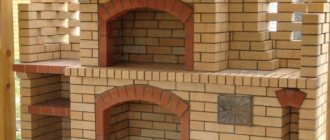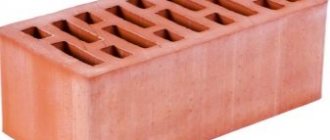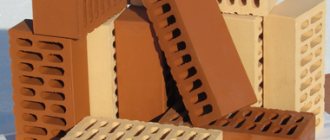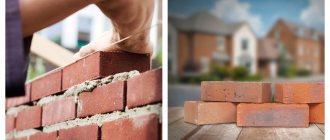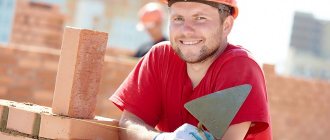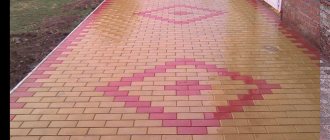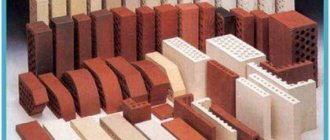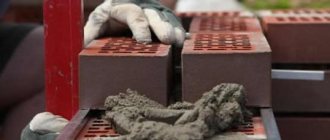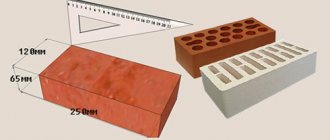Weight of fireclay bricks
Fireclay artificial stone is valued for its high strength and heat resistance.
Experienced builders recommend using it for laying stoves, fireplaces and chimneys. The weight of fireclay bricks depends on its type and size; they must be taken into account when drawing up a project for a future building. The stone is made from fireclay powder and special refractory clay, which are mixed with each other in equal proportions. The resulting product has a rough, fine-grained structure of a bright yellow color, but the content of small red inclusions is also acceptable. Briquettes have low thermal conductivity, can withstand high temperatures, are not afraid of high humidity, are environmentally friendly, strong and durable. The weight and dimensions of fireclay bricks depend on its type. There are several product classifications:
- According to the fire resistance class - it is marked ShA, can be used at temperatures up to 1400°C, and ShB - up to 1350.
- In shape - rectangular, trapezoidal and wedge-shaped, used for vaults and arches of stoves and fireplaces.
- In size - single, one and a half and thickened.
Mass of artificial stone
The weight of fireclay refractory bricks varies depending on its dimensions. Most often, products marked ШБ are used for laying stoves and fireplaces. Their mass is taken into account to evenly distribute the load on the foundation and other components of the building. ShB-5 fireclay brick weighs 3.4 kg with dimensions 230x114x65 mm, ShB-6 - 2.7 kg with dimensions 230x114x40 mm. Artificial stone marked ShA also has a digital designation 5, 6 or 8, its external volumes coincide with those indicated for ShB. The weight of fireclay ShB-8 brick is 4 kg, and the dimensions are 250x124x65 mm.
How to make the right choice
1. Check the strength of the briquettes and how well the firing technology was followed. To do this, take one copy and gently hit it with an iron object. If you have a quality product in front of you, you will hear a ringing sound, the instrument will seem to spring from it and vibrate in your hands. In the event of a strong impact, the briquette will not crumble, but will crumble into several large pieces. Incorrectly fired and poorly dried will give a dull sound and crumble into small pieces.
2. Be sure to make sure that the selected product is stored in appropriate conditions. It should be stored in a dry and well-ventilated area on wooden pallets. During transportation, the supplier is obliged to pack it in polyethylene.
3. Choose products with an even geometric shape and uniform shade, without chips, cracks or dents.
Product dimensions and weight
The weight of fireclay refractory bricks depends on the type and production method. So, according to GOST, a standard single product will weigh from 2.8 kg to 3.7 kg. When manufactured according to specifications, the maximum weight usually does not exceed 4.5 kg.
The size range of fireclay bricks is influenced by the geometry of the product:
- Straight standard parts have a length of 230 (250) mm, a width of 114 (124) mm and a height of 65 mm.
- For wedge-shaped elements, the most common parameters are 230*114*65/45.
- Trapezoidal bricks are found in sizes 250*124*65/55.
More precise dimensions and weight depend on the brand of product.
Classic dimensions of a fireclay block
Fireclay fire bricks ША-5, ШБ-5, ШБ-6, ШБ-8, ШБ-22, ШБ-23, ШБ-44, ШБ-45, ШБ-94
Application:
Fireclay refractory bricks (aluminosilicate fireclay products) are made from a mixture of fireclay grains and refractory clay, fired in ovens at high temperatures. Fireclay brick is widely used both in industry for laying stoves, boilers and other thermal units, and in everyday life as stove bricks, bricks for laying fireplaces and fireproof bricks for bathhouses.
Manufacturers
Fireclay bricks, like most refractory materials, are produced at enterprises in the Urals. engages in bricklaying and lining work and over many years has had the opportunity to evaluate refractory bricks from almost all Russian manufacturers. We chose the products of the Sukholozhsky Refractory Plant as the most stable and high-quality (excellent geometry, strength, ability to retain their properties for a long time at extreme temperatures).
Storage
In full compliance with GOST 24717-2004, we store fireclay bricks in a covered warehouse , since when moistened by precipitation, fireclay products lose their properties and are destroyed.
Characteristics
What does the marking on refractory brick mean?
Let's say there is a stamp on a brick: ШБ 5 SL
Ш - means that this product is fireclay aluminosilicate;
B - indicates that the brick meets the requirements of GOST and belongs to a certain class of refractories (for example A or B). If after Ш there is a number immediately, for example Ш 5, this, as a rule, means that the brick was produced according to the specifications. If a brick complies with GOST, this means that it has passed a rigorous selection process based on a number of parameters - size compliance, absence of chips and cracks, strength and temperature of use;
5 – indicates the geometric dimensions according to Table 2 of GOST 8691-73 (in this case 230x114x65 mm);
SL – name of the brick manufacturer (for example SL – Sukholozhsky Refractory Plant, BG – Bogdanovichsky Refractory Plant, etc.)
The maximum temperature for using fireclay bricks is:
• brick ШБ – 1350 С • brick ША – 1400 С
Along with straight bricks, wedge and trapezoidal bricks are widely used:
Fireclay brick dimensions, characteristics, weight and types according to GOST
Brick is an integral part of almost any construction. The most common and recognizable is the familiar red brick. However, there are several more types of bricks used in highly specialized work.
Fireclay brick is a special type of brick used for masonry exposed to high temperatures. This type is successfully used for laying furnace fireboxes, chimneys and other structures that have direct contact with fire. Due to its fire-resistant properties, such bricks can withstand temperatures up to 1800°C .
How fire bricks are made. Compound
Production involves firing a special mixture, on average 70% kaolin clay and 30% fireclay powder. Proportions may vary depending on the type of fireclay block being made. To give the product greater strength, coke or graphic impurities can be added to the mixture.
Firing is carried out under the strictest control of temperature and time parameters, which makes it possible to obtain a light yellow block with smooth surfaces (see photo).
To check the “authenticity” of the block, you can lightly hit it - if it is a real fireclay brick, when hit it will “respond” with a ringing, slightly metallic sound.
Deviations from the firing technology are unacceptable: if you “burn” the product, it will be covered with a transparent film that prevents adhesion to the laying mortar during laying.
Marking and symbols according to GOST
The characteristics of fireclay products are clearly regulated by the relevant technical documentation - GOST 8691-73 and GOST 390–96 . GOSTs specify all the technical characteristics and indicators that fireclay blocks must comply with.
For a clear classification of fireclay bricks, there is a certain marking that reflects the main characteristics of the product.
The marking consists of 2 or 3 letters and numbers:
The first letter is “Ш” , indicating that the brick belongs to fireclay products.
The second letter symbolizes the fire resistance class of the block. According to GOST, there are only three of them, each with a certain temperature maximum (see table below). If the second letter in the marking is missing, this indicates that the brick was manufactured not according to GOST , but according to TU - the standards of the manufacturer.
Red stove brick: dimensions, weight, price
Modern houses and apartments often have a fireplace or stove in their interiors, which not only have a heating function, but also create a cozy, soulful atmosphere in the room.
Basic properties of the material
The masonry material is usually red brick for the stove and fireplace, which is highly fire resistant and can withstand maximum temperatures: from +1400 to +1800 degrees Celsius. But when buying material, you need to know that the price of red stove brick depends on its type, size, density, as well as the manufacturer.
Product classification
Red brick for the stove
There are two types of material for laying stoves and fireplaces: simple and refractory refractory brick.
The refractory refractory material is hardened during the production process. The raw material for making bricks is high-strength clay, due to which the material is highly resistant to maximum temperatures. The product is used not only in the masonry of fireplaces, external and internal parts of stoves, but also in the construction of technical production structures, such as blast furnaces and others.
Simple red brick for stoves heats up much faster than refractory refractory material. This is considered an advantage of the product when choosing bricks for laying a stove or fireplace, because the main function of the material in this case is heat transfer and heating the room. The advantages of simple red brick, which distinguishes it from refractory refractory stone, include resistance to sudden temperature changes.
Product size and weight
GOST sets the dimensions of red brick for the stove and fireplace:
- refractory refractory brick must correspond to – 250Х123Х65 mm;
- a simple red brick should correspond to 250x120x65 mm.
You can see that the bricks differ only in width, the height and length of the products are completely the same. How much a red stove brick weighs depends on the size and density of the stone. The weight of the standard product is 3.4 kg. To calculate the foundation or load capacity of a vehicle transporting material, more precise data is sometimes required:
- a simple red brick with dimensions 250x120x65mm, weighs 4.2 kg;
- a simple red brick, measuring 228x115x64mm, weighs from 3.6 to 3.8 kg;
- the weight of a refractory refractory stone measuring 250x123x65mm is 3.4 kg;
- the mass of a refractory refractory stone measuring 230x113x65 mm is 2.9 kg.
How to choose quality material
Choosing a red stove brick
When choosing material for laying a stove or fireplace, you need to know how much red stove brick costs on average for a particular region and several main signs indicating the quality of the product. Only using high-quality material can you build a smooth and durable stove or fireplace.
When choosing products, special attention should be paid to the following features:
- The uniformity and evenness of the surface should be almost ideal. You should not purchase a brick on the surface of which you can find traces of impurities, stones, inclusions and, especially, cracks.
- The product must have a uniform, identical color on all sides.
- The correct shape of the stone speaks about its quality. It is necessary that all edges be without protrusions and gaps and have the same length. The presence of protrusions will lead to defects during laying.
- Different weights of bricks with the same dimensions indicate its density. The greater the weight, the denser the brick, the longer it accumulates and releases heat. It is also necessary to know the mass of material for constructing a foundation.
Popular publications:
In order to decide where to buy red stove bricks, you should know that suppliers set the price for the product themselves. Therefore, the best solution would be to purchase the material directly from the manufacturer.
How much does fireclay brick weigh?
Refractory fireclay brick differs from other materials in its increased resistance to heat and temperature changes. Also, one of its main advantages is the ability to store heat for a long time. Due to its characteristics, it is used for the construction of both conventional fireboxes and stoves in private buildings, as well as industrial facilities.
The limited range of use is due to a number of features of this refractory brick:
- quite high cost;
- the need to use a special high-quality mortar when laying;
- due to its high density, the material is difficult to cut;
- hygroscopicity - absorbs moisture well, which leads to an increase in weight and a decrease in strength characteristics.
Fireclay bricks are made by firing a homogeneous mixture consisting of fireclay (fireclay) and coke or graphite powder until elasticity is completely lost. It varies in shape, size, weight, as well as density and porosity. It can be rectangular and shaped (wedge- and trapezoidal, complex configurations), large and small dimensions. Piece fireclay products are marked depending on the fire resistance class and maximum thermal load. The number indicates the aspect ratio. The most commonly used brands are ША and ШБ.
According to GOST 390-96, the weight of one brick of standard sizes varies from 3.4 (for 230x114x63 mm) to 4 kg (250x124x65). It is directly affected by porosity. Examples of the dependence of weight on dimensions and shape for fireclay products of the ShA and ShB brands are given in the table:
| Product number | View | Size, mm | Weight, kg |
| 1–10 | straight | 230x65x65 | 1,9 |
| 250x124x75 | 4,7 | ||
| 345x150x75 | 7,8 | ||
| 11–15 | one and a half | 230x172x75 | 5,9 |
| 250x187x75 | 7,0 | ||
| 300x225x65 | 8,8 | ||
| 16–19 | three-quarter | 172x114x65 | 2,6 |
| 187x124x75 | 3,3 | ||
| 20–32 | end wedge | 172x114x65x45 | 2,2 |
| 250x124x75x65 | 4,3 | ||
| 345x150x75x65 | 7,3 | ||
| 49–54 | trapezoidal | 230x114x96x65 | 3,1 |
| 345x150x80x75 | 6,0 | ||
| 345x150x125x75 | 7,1 | ||
| 60–73 | heel | 114x114x144x133x34x57 | 2,8 |
| 172x230x144x201x52x144 | 9,1 | ||
| 250x230124x269x53x105 | 12,0 |
The relatively small mass of fireclay refractory bricks can significantly reduce the load on the foundation and does not affect the operational properties. Weight also affects thermal properties: the lower it is, the higher the thermal conductivity, therefore, better moisture absorption and stronger adhesion to the solution.
When purchasing fireclay bricks, special attention is paid to strength and compliance with firing technology. If you gently hit with an iron object, a ringing sound should be heard. After a strong impact, a high-quality product will fall apart into several large pieces rather than crumble. It is important that the middle of the brick is not too dark - this is a sign of non-compliance with the firing technology.
You should choose a product without chips and cracks, with a uniform shade over the entire surface, of the correct geometric shape (permissible distortion is no more than 2 mm). Of the several options, it is better to choose the heavier one - it is denser and, accordingly, stronger. You also need to make sure that the bricks are stored in the correct conditions. It should be stored in a dry, ventilated area on wooden pallets.
Types and markings of fireclay refractory bricks
Fire-resistant blocks can be classified according to several criteria:
By molding method
The design of the molds and features of the technological process provide for the following types of molding:
- casting from slips or melts;
- semi-dry molding;
- melting;
- hot pressing;
- thermoplastic pressing.
By block configuration
For masonry of various structures, the industry produces the following types of fireclay bricks:
- wedge-shaped;
- trapezoidal;
- rectangular (straight);
- arched profile.
By chemical composition
Depending on the additives used, which affect the heat resistance and mechanical properties, and the features of the production technology, the following modifications of fireclay refractory blocks are distinguished:
- basic.
In the manufacture of such bricks, fire-resistant fireclay clay is used, the mass fraction of which in the working mixture is 70%. Coke or graphite powder can be used as a filler. The material is used for lining furnaces intended for smelting Bessemer steel; - carbonaceous.
This modification is characterized by a high percentage of carbon. The main purpose of carbon refractory blocks is the lining of blast furnaces; - quartz.
Due to the use of silicon oxide, the heat resistance of bricks is significantly increased, however, contact with an alkaline environment leads to intensive destruction of the material; - alumina
Aluminum oxide is used as a special additive. Alumina fireclay bricks can operate for a long time at temperatures from 1100 to 1300 0 C and are little susceptible to frequent temperature changes. This type of heat-resistant blocks has become widespread when laying household stoves, fireplaces and chimneys.
The marking of fireclay bricks includes alphabetic and numerical designations that reflect the chemical and physical characteristics and overall dimensions of the material. Below is the labeling of the most common modifications.
SHA, ShB, SHAK.
The materials have high strength and heat resistance (1600 - 1700 0 C), which allows their use in all areas of industrial and civil construction. They contain aluminum silicate, which ensures long service life and resistance to mechanical damage. Another advantage is the optimal price/quality ratio.
Fireclay brick weight
The resistance of fireclay bricks to strong heat and sudden temperature fluctuations is ensured by a special production technology. It is used in the construction of industrial furnaces and fireplace chimneys. This stone is light yellow in color, with a porous structure and high thermal conductivity. Fireclay powder (fireclay) with the addition of graphite and coke is fired in a furnace at temperatures up to 1500 C. If it is burned, a glassy film forms on the brick. This product has increased strength, but loses its fire-resistant properties. If the brick is underexposed, it will attract moisture and quickly crack.
Fireclay brick weight: technical specifications, standard in cm
In the construction of stone structures operating under high temperatures, refractory bricks are used. Special additives are introduced into the composition of the products to prevent the appearance of cracks during strong heating. For the construction of industrial installations that use combustion energy, chimneys and fireplaces, fire-resistant bricks of different classes and sizes are required.
Fire brick dimensions
Depending on the type of additive, firing method and purpose with fire-resistant properties, products are divided into 4 classes:
- quartz (from sandstone or quartz);
- fireclay or alumina (clay products with the addition of fireclay);
- main (differs in calc-magnesian composition);
- carbon (made of pressed graphite or coke).
The last two types are used in industrial enterprises. They can withstand significant temperatures. For home stoves, baths and saunas, a fireclay sample is usually taken. Quartz brick withstands temperature well, but is destroyed under the influence of acids and other chemical factors.
The video describes the dimensions of refractory bricks:
Shape and weight standard
The following forms of refractory material are used in construction:
- straight;
- corner;
- wedge-shaped.
A good brick for the stove can be used without fear for the quality of workmanship.
Each type has its own markings and sizes. It is impossible to combine all types and brands of refractory bricks into one universal size. Initially they had no standard at all. Their size was indicated in vershoks (inches). The standard appeared only in the 19th century. Until that time, each workshop produced bricks of its own size.
The first standard in Russia appeared in 1927. They took German brick as a sample. Its dimensions: 250x120x65 mm are considered standard today. They were included in GOST. This standard size is considered to be the normal format. It is marked with the letters “NF” (normal format).
The properties of ceramic bricks and its other features can be read in the article.
A sample of a normal format is convenient to use: it is convenient for the master to hold it in his hand. All other sizes are derivatives of the normal format. Accordingly, the marking looks like this:
- 1 NF – 250x120x65 mm (single);
- 1.4 NF – 250x120x88 mm (one and a half);
- 2.1 NF) – 250x120x140 mm (double).
Fireclay brick size and other characteristics can be read in the article.
GOST also contains other less common product sizes. This is the so-called euro brick - 0.7 NF (250x85x65 mm) and single modular 1.3 NF - (288x138x65 mm).
The video shows the size of the oven refractory brick:
According to GOST 530-2012 for ceramic bricks, all faces have the name:
- poke - the longest edge;
- spoon - wide edge;
- the bed is a small edge.
Brick-like wall panels look very good both for exterior use and for exterior decoration.
The correct size makes the job easier. Standardization is used in the development of drawings and layout diagrams. The documentation usually indicates a fixed size of products.
Technical characteristics of kiln bricks
According to technical characteristics, depending on the weight and the difference in mass in construction, the following stove bricks are distinguished:
Heat resistant
For laying furnaces, heat-resistant bricks are used, which can withstand temperatures up to 1,000–1,300 °C, do not collapse during repeated heating and cooling, and are not susceptible to corrosion. Choose products with high strength (M150–M200). The numbers indicate how much load it can withstand. Thus, the mark M200 indicates that the brick can withstand loads of up to 200 kg per 1 cm 2.
It will be interesting to learn from the article about all the pros and cons of sand-lime brick.
Different parts of the furnace require different properties. The basis of construction is straight refractory brick. Only solid products of the following sizes are accepted for work:
- regular – 250x120x65 mm;
- thickened – 250x120x80 mm;
- modular – 288x138x138 mm.
The weight of a standard brick is from 3.5 to 3.8 kg. Fireproof other sizes weigh from 2.4 to 6 kg. A pallet usually holds 1,350–1,600 kg of bricks, which is 385–400 pieces.
High-temperature zones of stoves and fireplaces are constructed from red clay bricks and refractory and refractory bricks. They also use direct fireproof ones with dimensions of 250x123x65 mm. It is as close in size to the normal format as possible. Read the article about red brick size standards.
What is the size of a stove brick can be read in this article.
Read also about the standard sizes of white bricks for construction work.
The price of refractory bricks is several times higher than that of ordinary building bricks. One piece of fireclay brick costs from 30 to 55 rubles. For comparison: a regular full-bodied one is sold at a price of 8 rubles.
Chamotte
One of the most popular building materials for stoves, barbecues, fireplaces and other heating structures for domestic use is fireclay brick. The dimensions of this type of material are regulated by GOST 8691-73. The document also describes the performance properties, composition, and range of applications.
Features of fireclay brick masonry
The main feature is that ordinary cement mortar is not used for laying this type of brick because it does not have sufficient heat resistance.
Mortar for laying refractory bricks
In construction stores you can purchase a ready-made composition that has all the necessary properties, namely:
- glue for laying fireclay blocks has sufficient heat resistance;
- after drying, the properties of the material are similar to the parameters of the brick itself;
- the material has good adhesion to fireclay blocks.
If for some reason it was not possible to buy a ready-made composition, you can make it yourself, for this you will need:
- finely ground fireproof clay;
- fireclay sand;
- purified water.
The solution is prepared in the following sequence:
- Fire-resistant clay is filled with water for 24 - 72 hours and stirred periodically.
- The settled clay is wiped through a mesh with a cell no larger than 3x3 mm.
- The sand is sifted and added to the clay in a ratio of 2 parts sand to one part clay. The resulting composition is thoroughly mixed.
- Add water to the resulting mixture and mix again. The ready-to-use solution should have the consistency of sour cream.
- You can improve the quality of the mixture by adding 3% liquid glass or salt.
Features of laying heat-resistant blocks
There are a number of rules, compliance with which will ensure high-quality and durable masonry:
- The starting row is laid “dry”, without the use of an adhesive. When laying subsequent rows, an adhesive mixture is applied to the bottom and end surfaces, so that the thickness of the finished seam after laying does not exceed 5 mm;
- as soon as the brick fitting is completed, excess mortar should be removed immediately;
- the strength of the structure is ensured by laying the blocks with overlap (in a checkerboard pattern);
- the seams should be sealed flush with the side surface of the blocks. Recesses and unfilled seams will inevitably lead to cracks;
- when laying corners and decorative elements, the blocks are laid with the front side out;
- cutting fireclay bricks should be done with a grinder equipped with a diamond saw blade; using a trowel or pick to adjust dimensions is highly undesirable;
- the finished structure does not require any additional treatment with special compounds, primers, etc.
Strict adherence to these simple rules will ensure long service life and reliability of the structure.
Since structures operating in conditions of high and extreme temperatures are particularly critical, the correct choice of material is of particular importance. The use of fireclay bricks ensures high heat resistance, resistance to mechanical stress and sufficient fire safety of the structure. In addition, we should not forget that the use of ordinary ceramic or sand-lime bricks when laying heat-resistant elements will not only not give the desired results, but will also significantly increase the risk of fire.
Calculation of the weight of fireclay bricks
- Peculiarities
- Standard fireclay products
- Characteristics by brand
- Example calculation
Construction materials should be used only with strict consideration of the load created on the foundation. That is why you should carefully monitor the weight of fireclay bricks. In addition, the organization of transportation of products depends on this.
Peculiarities
SHA-8 and SHA-5 are the two most commonly used versions of fireclay bricks. They are obtained by firing a clay mixture of a certain shape under significant heating. To produce the product, a combination of kaolinite with other minerals is used. The technology implies that the finished composition must contain a certain amount of aluminum and silicon oxides. The two brands of fireclay bricks mentioned above are widely used for:
- installation of stoves and fireplaces;
- construction of chimneys;
- lining of melting furnaces at metallurgical plants.
By selecting the composition of refractory bricks, technologists have learned to influence not only its thermal resistance. Differences in chemical composition cause differences in density (specific gravity). So, 1 pc. fireclay brick category SHA-5 weighs 3.4 kg. Moreover, its linear dimensions are strictly prescribed in state standards and amount to 230x114x65 mm. In accordance with GOST 390, a brick measuring 250x120x65 mm must have a mass of 4 kg.
Standard fireclay products
GOST 390-96 also prescribes the mass of bricks laid on 1 pallet. It can vary from 1350 to 1600 kg. This involves laying 385-400 pieces of finished products. Weight of one cubic meter m of refractory brick ranges from 1745 to 2050 kg. Regardless of the total weight of 1 cubic meter. m should include exactly 513 pieces.
Characteristics by brand
When choosing fireclay bricks, there is no need to calculate the mass of products using complex formulas. It is enough to know the specific technical brand of the finished product. So, a lightweight brick of category ШБ 5 should weigh 3.5 kg. It is used to decorate stoves, barbecues, and make fireplaces and barbecues. Fireclay of category ША 5 has a mass of 3.4 kg. It is intended for individual residential construction.
Blocks ША 5 and ШБ 5 must have the same size - 230x114x65 mm. ShA 6 blocks, intended for laying out thermal and heating equipment, are also produced in standard dimensions - 230x114x40 mm. Moreover, the mass of such a product is 3.4 kg. The heaviest products are SHA 8. They are needed to form internal masonry in heating stoves and smoke ducts.
Example calculation
Let the construction of a furnace with a height of 2400 mm (with a base of 24 bricks) be planned. Each row has a height of 70 mm, and 300 mm is subtracted from the planned height for “cutting”. In total, 30 rows of masonry remain, and after multiplying by 2/3 (the usual proportion in the construction of “Dutch buildings”), only 20 rows will remain. The result is 480 bricks (plus 50 for “cutting”).
If you order fireclay brick ShB-5 straight, then 1 pallet will contain 385 blocks with a total weight of 1309 kg. The total requirement in this case is 530 bricks with a total weight of 1802 kg. We can conclude: 1.37 pallets of building blocks are required. You can bring them in a Gazelle-type car, but the car will be overloaded.
If you order straight fireclay ShB-8, 1 pallet will contain 297 blocks with a total weight of 1188 kg. The weight of a single product will be 4 kg. Thus, 530 pieces will weigh 2120 kg. Therefore, you will have to order a full-fledged truck to deliver a batch of fireclay bricks to the site. Of course, in reality, the size of the stoves and the number of blocks used for masonry changes, and the chimney should also be taken into account, but the general principle of calculation remains unchanged.
You will learn more about fireclay bricks from the video.
Important characteristics of fire bricks
The presence of a large assortment of heating equipment on sale does not reduce the attachment to well-made stoves that are familiar to everyone. The ability to build a stove used to be passed on by word of mouth.
There are now more opportunities for learning. In addition to masonry, the master must know how to choose and use the material correctly.
Not just any type of brick is suitable for building a furnace, but only refractory bricks that have special characteristics. A mistake or carelessness when purchasing can ruin all the work.
Production
Clay, an inorganic fossil from sedimentary rocks, is used to produce many building materials with fire-resistant characteristics. Clay raw materials are varied. It is a mixture:
- silicic acid salts (silicates);
- silicon and aluminum oxides;
- water from underground sources.
Sedimentary rocks contain admixtures of colored components inherent in each area.
When producing refractories, raw materials are necessarily fired at high temperatures. As a result, all moisture evaporates and the mineral components are sintered. The product loses its plasticity and turns into a particularly dense stone with fire-resistant characteristics.
Subsequent stages of the technological process include grinding of raw materials; adding additives: graphite, coarse coke or quartz powders; adding small amounts of water (no more than 10%) until the required consistency is formed.
The resulting mass is immersed in a hopper, from which it enters the dispenser. A brick made from a portion of the mineral mass is pressed and fired.
The presented technological scheme is widespread and well developed. All characteristics, including the weight of refractory bricks obtained by this method, are stable and meet the requirements of GOST.
Properties
Fireproof properties are: normal (1580 - 1770 ℃), high (1700 - 2000 ℃), highest (more than 2000 ℃).
Based on the volume fraction of cavities, products are divided into several groups:
- particularly dense products have a porosity of less than 3%;
- high-density – 3 – 10%;
- dense – 10 – 20%;
- regular - 20 - 30%;
- lightweight and thermal insulation – 45 – 85%.
Based on the type of raw materials, characteristics, and application features, heat-resistant bricks are usually divided into several types.
Basic (main) refractory brick contains calcium and magnesium carbonates and is used for finishing steel furnaces. It has maximum strength and thermal conductivity compared to other refractories.
The characteristics create ideal conditions for the smelting of Bessemer steel. There are other types of refractory bricks with specific characteristics.
Types of refractories
Carbon brick differs in composition from other refractory products. It is based on graphite or coke, the content of which is close to 92%. Carbon brick products have a narrow purpose. Blast furnaces are made from it.
Quartz brick is made from a mixture of quartz and sandstone. The main advantage is its high density. Quartz products make reliable chimneys, fireplace walls, and some types of stoves.
The material is chemically unstable; may react with acidic and alkaline substances; metal oxides.
Dinosaur refractory brick consists of 94% silicon oxide and retains strength well at high temperatures, reaching 1690 ℃. The material, in accordance with its characteristics, is ideal for open-hearth furnaces and regenerators.
Semi-acid brick is classified as fireclay brick. Its composition is represented mainly by aluminum and silicon oxides. The material can be heated in an oven up to 1670℃. It tolerates mechanical loads well; has a large number of pores (up to 30%), lower density than other refractories.
Products with a predominant (62%) aluminum oxide content are called mullite. If the mass fraction of aluminum oxide (alumina) exceeds 90%, then the products are called corundum.
High-alumina bricks are used for laying linings in the construction of metallurgical enterprises.
Alumina brick, which is often called simply fireclay, has found the widest range of applications. It contains a high concentration of clay (chamotte) and can withstand temperatures up to 1400 ℃.
It tolerates temperature changes well and is inert to the action of alkaline components. Fireclay alumina products are used everywhere in everyday life and industry due to their good performance characteristics.
Fireclay products
The special clay raw materials necessary for the production of fireclay bricks are mined by open-pit methods.
Developments do not require large financial investments. The energy costs for manufacturing products are moderate, which is facilitated by well-developed technology.
As a result, fireclay bricks have a price that is quite affordable for the majority of the population. It is this type of refractory product that is most often used for laying stoves in private housing construction.
The technology is implemented with some features. Therefore, the products have a wide range of densities. Average values vary from 1700 kg/m3 to 1900 kg/m3. There are products with a minimum density of 300 kg/m3 and a maximum of 2100 kg/m3.
Conventional fireclay bricks can withstand temperatures from +1250 ℃ to +1690 ℃. There is a fireclay brick whose specifications indicate a maximum temperature of 1800 ℃. Such products are used in industrial facilities.
